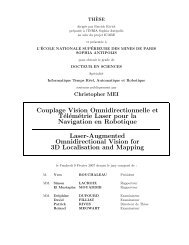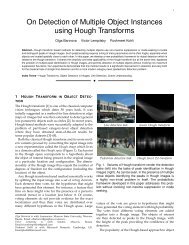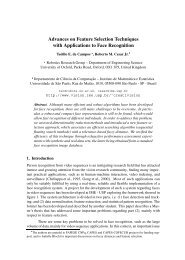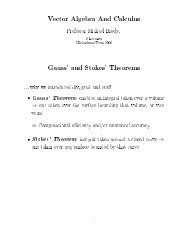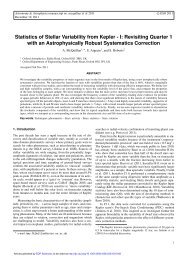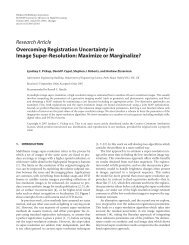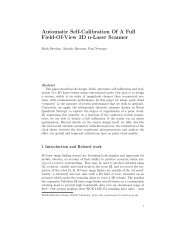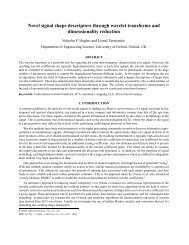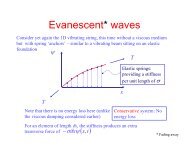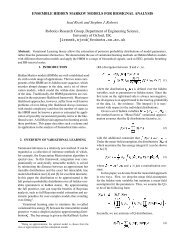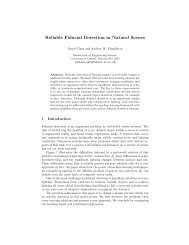Online Model Selection Based on the Variational Bayes
Online Model Selection Based on the Variational Bayes
Online Model Selection Based on the Variational Bayes
You also want an ePaper? Increase the reach of your titles
YUMPU automatically turns print PDFs into web optimized ePapers that Google loves.
<str<strong>on</strong>g>Online</str<strong>on</strong>g> <str<strong>on</strong>g>Model</str<strong>on</strong>g> <str<strong>on</strong>g>Selecti<strong>on</strong></str<strong>on</strong>g> <str<strong>on</strong>g>Based</str<strong>on</strong>g> <strong>on</strong> <strong>the</strong> Variati<strong>on</strong>al <strong>Bayes</strong> 1675<br />
C Qh (µ )-independent terms<br />
Z<br />
D dm (ZfTg)Qz(ZfTg)<br />
" TX<br />
#<br />
£ (r(x(t), Z(t)) ¢ hµiQ C r0(x(t), Z(t))) ¡ log Qz(ZfTg)<br />
h<br />
tD1<br />
C Qz(ZfTg) - independent terms,<br />
where h¢iQ and h¢iQz denote <strong>the</strong> expectati<strong>on</strong> value with respect to Q h h (µ ) and<br />
Qz(ZfTg), respectively.<br />
Appendix B<br />
The calculati<strong>on</strong> of <strong>the</strong> derivative of <strong>the</strong> parameterized free energy (see equati<strong>on</strong><br />
2.26) is lengthy but straightforward. The outline of <strong>the</strong> calculati<strong>on</strong> is<br />
shown below. The derivative with respect to µ<br />
N can be calculated as<br />
@F/@ N �<br />
@<br />
µ D T<br />
@N µ hr(x, z)i ´<br />
N (hµi<br />
µ ® ¡ µ N ),<br />
by using <strong>the</strong> relati<strong>on</strong><br />
@<br />
@N �TX ´ �<br />
log P(x(t)| µ<br />
N ) D T hr(x, z)i N ¡<br />
µ<br />
µ @Ã<br />
@N ´<br />
.<br />
µ<br />
tD1<br />
The coef�cient matrix T(@hri N /@<br />
µ N µ ) turns out to be U(µ ) de�ned in equati<strong>on</strong><br />
2.28.<br />
The derivatives with respect to (®, c ) are given by<br />
1<br />
c<br />
@F<br />
@® D<br />
�<br />
1<br />
c 2<br />
@ 2 W<br />
@®@® T<br />
´<br />
¢ ± ²<br />
Thr(x, z)i N C c 0®0 ¡ (T C c 0)®<br />
µ<br />
�<br />
1 @<br />
C (T C c 0 ¡c )<br />
c<br />
2 W 1<br />
¡<br />
@®@c c 2<br />
´<br />
@W<br />
,<br />
@®<br />
1<br />
¡<br />
c 2<br />
´<br />
@W<br />
¢<br />
@®<br />
± ²<br />
Thr(x, z)i N C c 0®0 ¡ (T C c 0)®<br />
µ<br />
� 2 ´<br />
@ W<br />
C (T C c 0 ¡c ) .<br />
@c @c<br />
@F<br />
@c D<br />
�<br />
1 @<br />
c<br />
2 W<br />
@®@c<br />
Equati<strong>on</strong>s 2.30 and 2.31 can be derived by using <strong>the</strong> above and <strong>the</strong> following<br />
equati<strong>on</strong>s:<br />
1<br />
c 2<br />
@ 2 W 1<br />
D<br />
T @®@® c 2<br />
½ � @ log P a<br />
@®<br />
´ �<br />
@ log Pa @® T<br />
´¾<br />
,<br />
®



